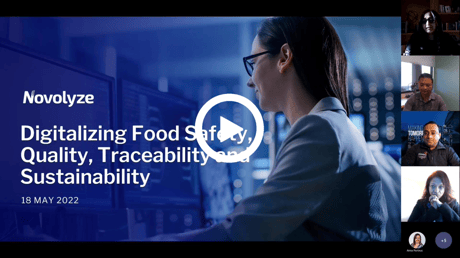Diving Deeper into the Digitalization Journey: Online Forum Highlights
After a first session where our guest speakers went over the factors and challenges of digitalizing food safety, quality, traceability and sustainability, we had the pleasure to host Priya Sundaram from Bob Evans, Derrick Bautista from Del Monte Foods and Vijay Krishna from Glanbia for the second part of our online forum series.
In this session, Priya, Derrick and Vijay go over how to define your digital needs, identify potential pain points, and kickstart your digitalization projects.
Determining your Digitalization Needs
For Priya, the best approach to define the digitalization needs for Food Safety & Quality is to start from the overall company goals. A digital solution should be serving at least one of the company's performance objectives. This also makes alignment with top management easier along the digitalization journey.
Then it is necessary to clearly identify what problem you are trying to solve, how big or complex the project will be and who are the primary beneficiaries. As mentioned by Vijay, it is important to look at the processes and workflows. It's a common mistake to jump into a digitalization project thinking that software will solve everything but frequently the issue comes from the process and no amount of external software can solve that.
Vijay also shared an interesting tip for the definition of digitalization needs. "You can have a document that describes current state, which is what is happening today" he said, "and future state; when this is done, irrespective of the solution used, what the future state looks like." In a written form it can be clearly understood, articulated and aligned with key stakeholders.
Derrick presented a recent example from Del Monte Foods where they were looking to improve efficiencies for their quality managers. The one key thing that they noticed is the amount of effort that is required to look at paperwork. Derrick mentioned that the quality managers "would spend up to four hours a day just piling through all the paperwork" so they tried to see how they could build efficiencies and spend less time looking at paper and improve the operational aspects of the business.
Identifying Potential Pain Points
Our experienced guest speakers highlighted the potential pain points that food safety and quality professionals can experience when going through the process of digitalization. Knowing and anticipating them can help make the digital transformation a smoother journey. Pain points usually appear due to misalignments at the initial stage of the definition of needs and here are a few of the potential reasons:
-
The project affects other teams (Supply Chain, R&D, etc.) that were not involved from the start
-
What was identified as an issue to be solved, is not an issue for these other teams
-
The gap between current and future state is more complex than identified at the beginning and/or it doesn't fit with the other ongoing projects the team is dealing with
-
The responsibility of each team or individual is not clear and their is a misalignment on who is supposed to be doing the work
-
The digital solution is tailored to the needs of the corporate individuals and not designed for the primary stakeholder
-
The financial work and ROI modeling was not performed thoroughly, showing too ambitious cost savings
Kickstarting Your Digitalization Journey
The guest speakers shared valuable practical tips during the online forum about how to take the first steps toward your digital journey.
A digitalization project should be approached like any other project, a new product development, a reformulation, etc... the way to start a project is usually different in every company. For Vijay, you should look at your company, "look at how a project got incepted, how an idea goes from idea to creation, and you use those vehicles."
It is key to involve the right people, at the right moment. Usually the right people are the ones who have the same goal, and benefit from the project. A common goal can also be set up for a certain group of people. As mentioned by Priya, "the C-suite executive who has oversight (over the project) should be the first stakeholder that you involve." Remember that without having at least some elements on the potential solution, feasibility, timeline, cost, and some element of ROI, there is no point in engaging stakeholders from the C-suite, because "that's what they're going to ask" said Priya.
Once the members of the team involved, a clear digital roadmap can help keep them and the rest of the company engaged on the big picture as much as with the ongoing project. Everyone should remember that digitalization is a journey and not a destination.
Finally, you should have clear KPIs from the start of the project for the current state but also the future state, and the goals you want to achieve. Derrick mentioned a few examples such as efficiency, paper reduction, headcount reduction or repositioning. For a better impact when communicating on the KPIs, it is best to translate the benefits in terms of financial outputs and you may need assistance from your finance department to help you guide though that calculation. Intangible benefits should not be forgotten; they are usually harder to identify but have a big impact in the long term.
Steps of a Digital Project
Priya walked us through the following steps of a digital project starting from leadership alignment and budget approval:
-
Building your feature set
(What are your must haves and nice to haves?) -
Request For Proposal (RFP) process
(Including demos from solution providers) -
Selection of vendor
-
Customization / building of the solution
(biggest watch out is how much time you're going to need to customize and actually develop the solution for launch) -
Training and post launch support
To conclude, Priya, Derrick and Vijay wanted everyone to remember that it's not always about the final destination, but what you see along the way. Digitalization is an enriching experience, with a lot of learnings. Communicate with your network, question your current process, test and reflect and don't be afraid to acknowledge when something is not going your way, and you will make the best of your digitalization journey.
Would you like to hear more about the digitalization of Food Safety and Quality from industry experts? Register for our webinar series.






